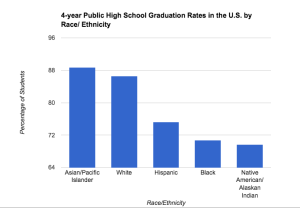
Native American students have the lowest graduation rate in Arizona and nationally, according to data from the 2012-2013 school year, but one Tucson school district is trying to help change that trend.
About 70 percent of American Indian/Alaskan Native students graduated from a four-year high school in 2012-13 in the United States, according to the National Center for Education Statistics. Asian/Pacific Islanders graduated at 89 percent, followed by Anglos (87), Hispanics (75) and African-Americans (71).
Only 61 percent of American Indian/Alaskan Native students graduated from a four-year Arizona public high school in 2012-13 school year, according to the National Center for Education Statistics. Asian/Pacific Islanders came in at 84 percent, followed by Anglos (83), African-Americans (70) and Hispanics (69).
The lower economic status of many Native Americans can play a part in the lack of academic success, said Keith James, department head of the American Indian Studies department at the University of Arizona.
Pregnancy, substance abuse and household issues are contributing factors to dropout rates within the Native American student population at Sunnyside Unified School District, said Kevin Fortuin, director of the district’s Native American Education Program.
“Substance abuse and household issues become the reason why students stay in school, but it can also be a reason to drop out of school,” Fortuin said.
Through the Sunnyside district’s program, 73 percent of Native American students enrolled at Desert View and Sunnyside high schools graduated within four years — 3 percent better than the 2012-13 national rate.
The program is specifically catered to meet the “unique educational needs of Native American students,” Fortuin said.
While education and graduation rates do vary by Native American populations throughout the country and within different tribal groups, James said that intergenerational trauma may also be a contributing factor to the Native American population’s low academic success rates.
According to James, a large percent of the Native American community went through a time when people were taken from their native land to boarding house style homes and robbed of and often punished for practicing their cultural, lifestyle and social norms.
This occurred on Canadian American Indian land up until the 1970s and in the United States until the 1950s, James said.
“Think of the boarding schools ending in the 1950s, that would be my parents,” James said. “They were traumatized by their experience and they don’t have a history of growing up in a family so they don’t know how to raise children or deal with people.”
Native Americans who were affected by the secular and nonsecular boarding houses often carry long-term post traumatic stress disorder without seeking help and then they transmit that to their own children, according to James.
Often, when Native American students from rural communities begin the enrollment process at the University of Arizona, parents struggle and do not know how to deal with online application systems and financial aid forms, James said.
Of 4,064 students who identify as Native American or Alaskan Native, only 63 percent graduated from a four-year high school cohort in 2014, up 2 percent from 2012, according to the Arizona Department of Education.
The Sunnyside district’s program aims to serve as an advocate, liaison and mentor for students, advisers and families of Native American students.
Culturally, the program is designed to help schools better understand the backgrounds that students come from and their cultural norms, Fortuin said.
“Education tends to cater around white middle-class culture, so white middle-class people tend to be successful in education,” Fortuin said. “In order to best educate them, we need to be able to educate them through their own lenses.”

The program caters to about 900 Native American students throughout the Sunnyside district. About 30 percent of those students live in the Tohono O’odham community, while the remaining 70 percent live in urban areas of Tucson, according to Fortuin.
The district’s success rate declined rapidly between 2012 and 2013, dropping nearly 10 percent. However, it increased to a 73 percent graduation rate in 2014 with 40 Native American Students between the two schools.
A team of counselors cater to the district’s Native American student population.
Angelina Bautista, a junior at Sunnyside High School, said the Native American Education Program has been a support system for her throughout her studies.
Bautista plans on joining the Marines after graduation. She is confident that she will pursue higher education to fulfill her goals of working in law enforcement.
“Sometimes it can be hard and stressful, and there’s days when I wake up and don’t want to go to school, but in the end it’s worth it,” Bautista said.
Adriana Espinosa is a reporter for Arizona Sonora News, a service from the School of Journalism with the University of Arizona. Contact her at [email protected]

